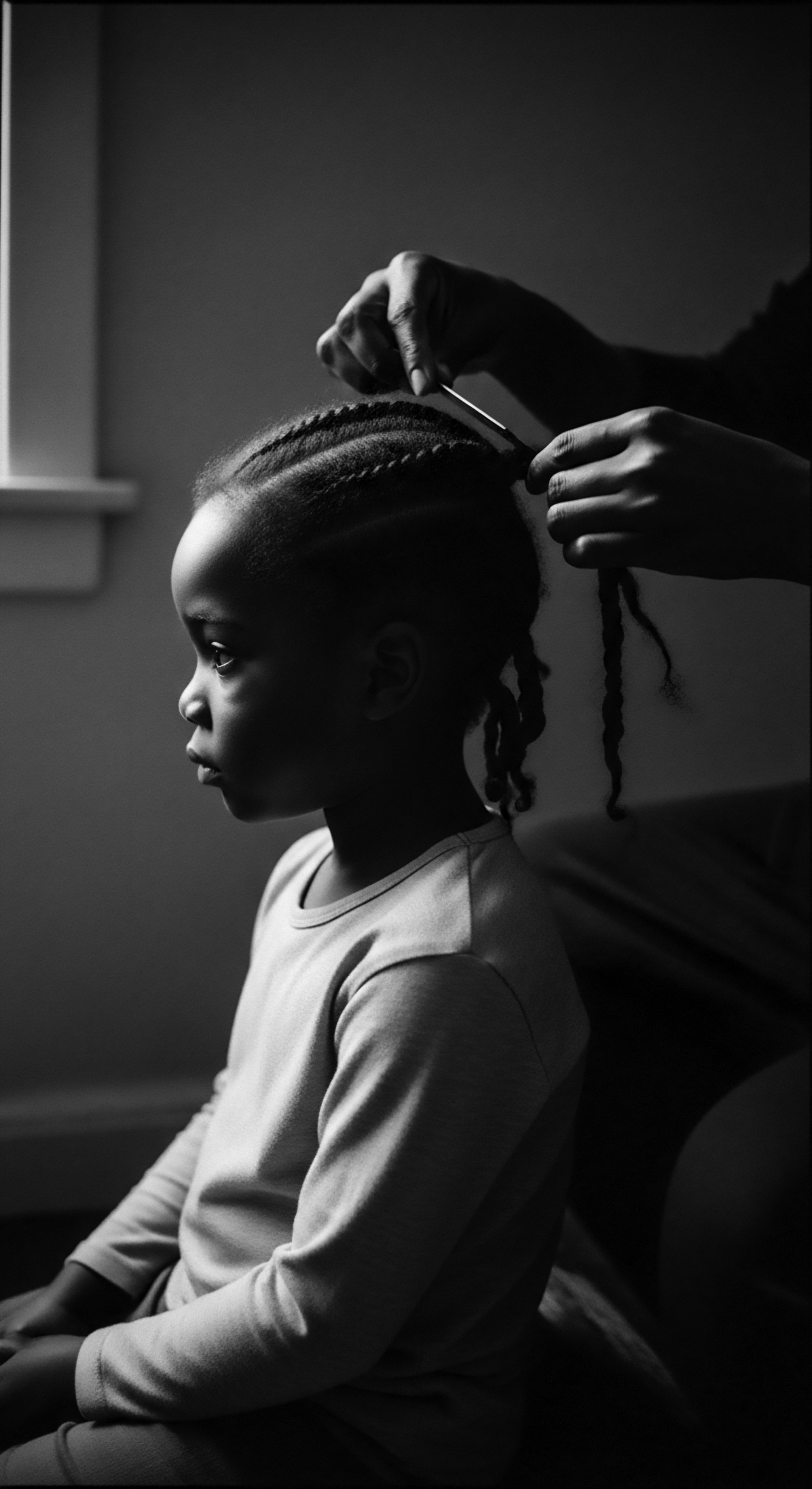
Fundamentals
The concept of a Humidity Shield for textured hair revolves around creating an effective barrier that protects strands from atmospheric moisture. This protective measure is designed to mitigate the unwelcome effects of high humidity, particularly the propensity for frizz, loss of curl definition, and the often-cited sensation of hair feeling limp or overly expanded. Such a shield helps to maintain the desired structure and integrity of textured hair, allowing it to hold its chosen style for extended periods. It acts as a guardian, preventing the hair shaft from absorbing excessive water molecules from the surrounding air.
At its core, the Humidity Shield serves to stabilize the hair’s internal moisture balance. Textured hair, by its very nature, possesses a unique architecture, often characterized by a lifted cuticle layer and an elliptical cross-section. This structural particularity makes it more susceptible to environmental shifts. When the air is heavy with moisture, water particles can infiltrate the hair shaft, causing the hair protein (keratin) to swell unevenly.
This swelling disrupts the cuticle, lifting it further and leading to the familiar appearance of frizz. A well-designed Humidity Shield works to smooth the cuticle and seal the hair’s outer layer, thereby slowing the rate at which water can enter or exit the strand. This preserves the hair’s hydration while repelling external humidity, fostering resilience.
Consider a plant in a dry season, its leaves curling to retain precious water, then observe it after a rainfall, unfurling to drink deeply. Hair, in a similar yet inverse manner, reacts to its environment. In humid conditions, without a shield, textured hair can become overly saturated, losing its inherent spring and definition. This simple explanation clarifies the practical intention behind applying a Humidity Shield ❉ it creates a protective envelope around each strand, a safeguard against the vagaries of weather, allowing the hair’s beauty to persist unburdened.

Intermediate
Moving beyond the basic understanding, the Humidity Shield functions as a sophisticated mediator between the hair fiber and its atmospheric surroundings. Its primary designation centers on managing the intricate interplay between hair’s hygroscopic nature and the fluctuating levels of water vapor in the air. Textured hair, characterized by its distinct coil patterns and often elevated cuticles, naturally possesses a greater surface area and more points of entry for environmental moisture.
This inherent structural characteristic means that, in a highly humid climate, the hair readily absorbs water, leading to a phenomenon known as hygral fatigue, where repeated swelling and deswelling can weaken the hair shaft over time. The Humidity Shield intervenes in this process, forming a hydrophobic layer that significantly reduces water absorption.
The true meaning of a Humidity Shield resides in its dual capacity ❉ it works to preserve the internal moisture balance of the hair while simultaneously repelling external dampness. This protective action is achieved through specialized ingredients, often film-forming polymers or specific lipid compounds, that coat the hair strand. These components align and flatten the cuticle, creating a smoother, less porous surface.
This physical barrier acts as a deterrent, preventing airborne water molecules from penetrating the hair’s cortex and disrupting its hydrogen bonds, which are responsible for holding the hair’s shape. When hydrogen bonds are broken by excessive moisture, curls can loosen, flatten, or become undefined, resulting in a frizzy appearance.
The Humidity Shield establishes a critical equilibrium for textured hair, preserving its intrinsic moisture while gracefully deflecting the unpredictable whims of atmospheric dampness.
Historically, communities with rich traditions of textured hair care developed their own empirical methods of creating such shields, often through the diligent application of naturally occurring oils, butters, and plant extracts. These ancestral practices, passed down through generations, reveal an intuitive understanding of the hair’s needs long before modern chemistry articulated the specifics. Palm oil, rich in fatty acids, and various plant resins, for instance, were used to coat and protect hair, especially in regions prone to high moisture. This ancestral knowledge provided a foundational understanding of how to manage hair in diverse environmental conditions, an understanding that continues to inform contemporary formulations.
The application of a Humidity Shield is not merely about aesthetic preservation; it supports the structural health of the hair fiber, lessening the strain of constant environmental assault. It signifies an intentional act of care, acknowledging the hair’s delicate balance and ensuring its vitality endures against external pressures.

Academic
The editorial definition of a Humidity Shield, particularly in the context of textured hair, extends into a complex interplay of biophysical chemistry, material science, and profound cultural heritage. A Humidity Shield, from an academic vantage point, signifies a formulation or treatment designed to regulate the hygroscopic interaction between the hair fiber’s keratinous structure and ambient atmospheric water vapor. Its primary function centers on maintaining the thermohygrometric stability of the hair shaft, thereby preserving its mechanical properties, aesthetic conformation, and structural integrity. This is achieved through the deposition of a hydrophobic or amphiphilic film that mitigates the ingress or egress of water molecules, which is critical for hair types highly susceptible to environmental fluctuations, such as those found across African and mixed-race ancestries.
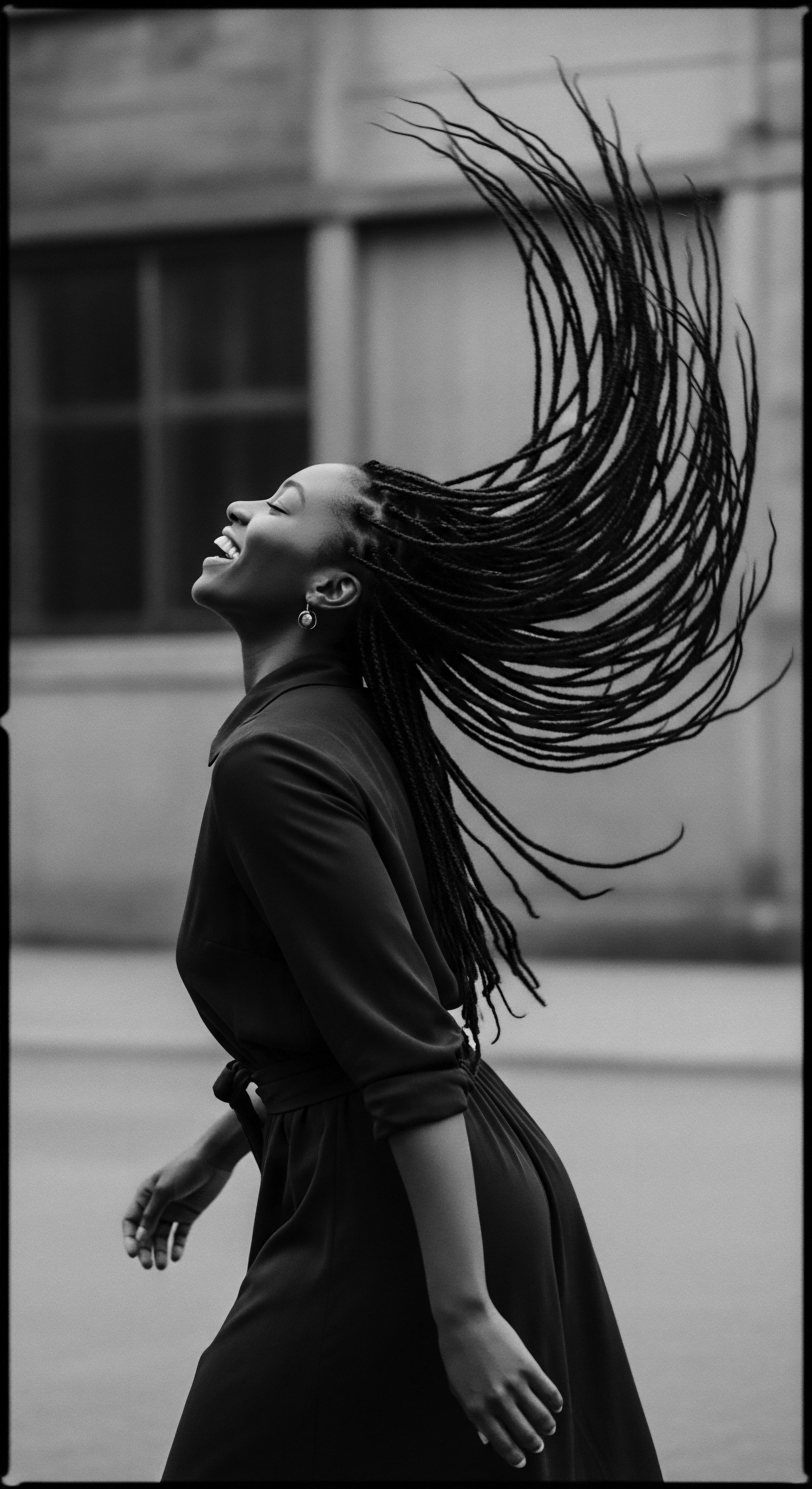
Biophysical Mechanisms and Hair Morphology
Textured hair, with its unique helical twists, varying curvature, and typically elevated cuticle layers, presents a distinct challenge in high-humidity environments. The hair cortex, composed largely of keratin proteins, contains numerous hydrogen bonds that provide tensile strength and contribute to the hair’s characteristic shape. When exposed to elevated relative humidity, water molecules readily penetrate the hair shaft, disrupting these labile hydrogen bonds.
This phenomenon leads to significant swelling of the hair fiber, an increase in its diameter, and a subsequent alteration in its mechanical properties, often manifesting as reduced elasticity, increased stiffness, and the disorganization of curl patterns, commonly described as frizz. The hydrophilic nature of the hair’s internal structure means it acts as a sponge, particularly when the external humidity gradient favors absorption.
A Humidity Shield’s purpose is to stabilize the nuanced relationship between hair’s intrinsic structure and environmental moisture, fortifying the hair’s resilience against climatic shifts.
Academic research has demonstrated that hair from individuals of African descent often exhibits unique lipid profiles, with African hair showing a remarkably lower radial swelling percentage in water due to higher apolar lipid levels compared to Asian and European hair . This innate biological characteristic suggests a natural predisposition for moisture management within textured hair, an evolutionary adaptation to diverse climates. However, even with this inherent resilience, external interventions remain critical in highly challenging environments or when hair has been chemically or mechanically altered, which can compromise its natural lipid barrier.
Humidity Shields typically function by applying a non-water-soluble, often polymeric or lipid-rich, layer onto the hair cuticle. These film-forming agents create a physical impediment to water molecule transfer. Common agents include silicones (like dimethicone or cyclomethicone), specific emollients, or humectants that bind water more strongly than the hair itself, preventing it from being absorbed into the keratin cortex.
The goal is to stabilize the water activity within the hair shaft, preventing the rapid uptake or loss of moisture that causes structural distortion. This protective action maintains the hair’s hydrogen bond network, thereby preserving curl definition and reducing frizz.
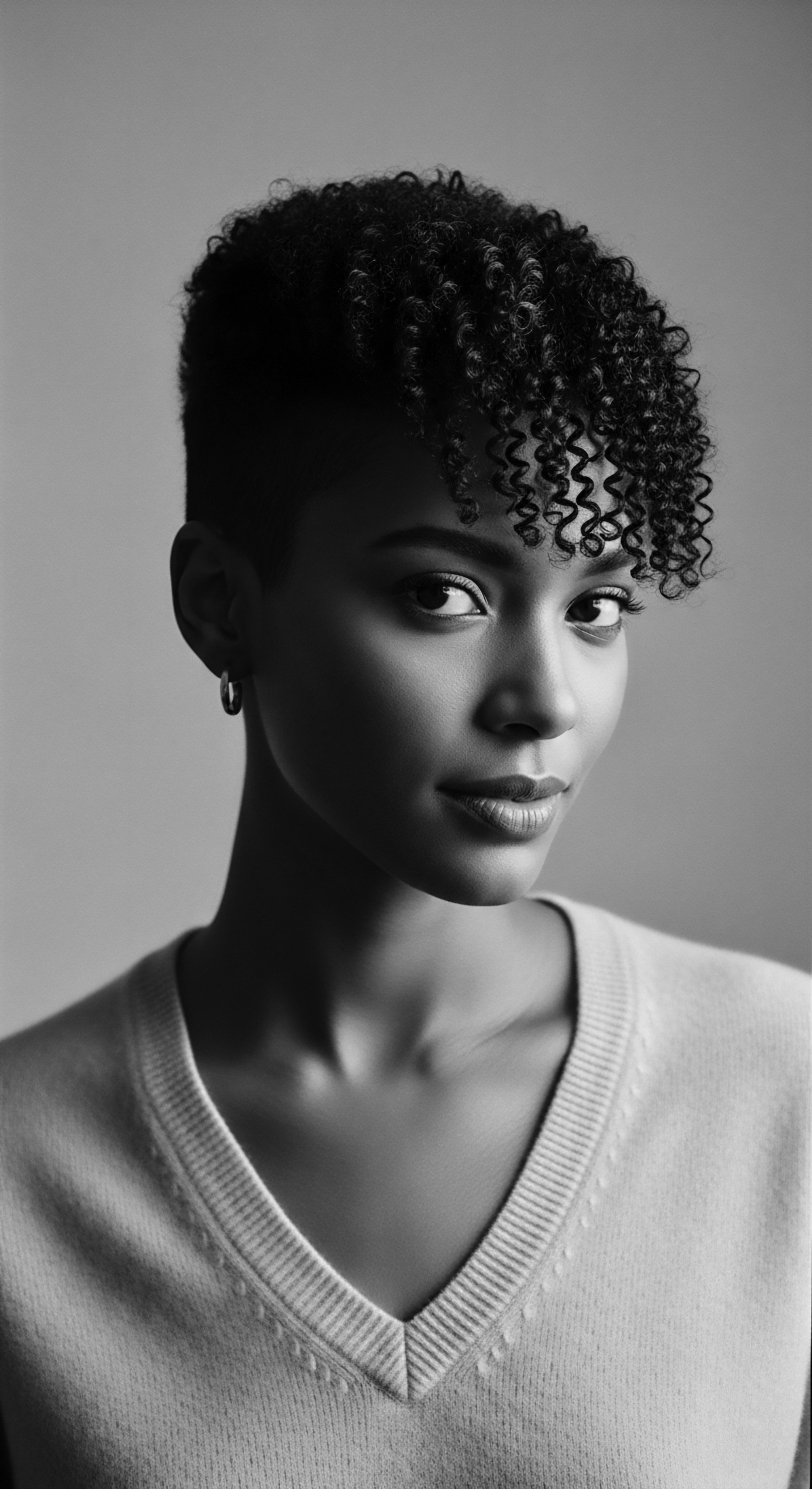
Ancestral Practices and Empirical Wisdom ❉ Echoes from the Source
The contemporary scientific conceptualization of a Humidity Shield finds compelling resonance in ancestral hair care practices, particularly within Black and mixed-race traditions. For millennia, communities across the African continent and its diaspora cultivated sophisticated regimens to protect and adorn textured hair, often responding directly to environmental challenges, including humidity. These practices were not born of laboratory experiments, but from generations of keen observation, empirical refinement, and a deep, intuitive understanding of botanical properties.
A powerful instance of such ancestral wisdom is the widespread and long-standing use of Shea Butter ( Vitellaria paradoxa ) across West Africa. For over two millennia, women in regions spanning from Senegal to Uganda have meticulously harvested and processed shea nuts to yield a rich, unrefined butter . This indigenous knowledge extends beyond culinary or medicinal uses, profoundly influencing hair care. Historical accounts suggest that ancient figures, including potentially Cleopatra, valued shea butter for its protective qualities, transporting it across vast distances to shield skin and hair from harsh climates .
The empirical effectiveness of shea butter as an ancestral humidity shield is scientifically affirmed by its unique compositional profile. It is rich in essential fatty acids, such as oleic acid (up to 60%) and stearic acid (up to 40%), along with significant unsaponifiable components including triterpenes, tocopherols (Vitamin E), and phytosterols . These lipids create a substantive, occlusive layer on the hair shaft. This layer not only imbues the hair with moisture but crucially, by reducing the hair’s effective porosity, it significantly slows the rate of water absorption from the atmosphere.
The result is a profound reduction in frizz and a prolonged preservation of natural hair patterns, even in tropical, moisture-laden environments. Its application was a pragmatic response to climate, and a ritualistic act of care, recognizing hair as a vital part of personal and communal identity.
Consider the Fulani Silk Method, a traditional practice from West Africa, particularly among the Fulani people of Nigeria, developed to combat dryness and retain moisture . This method involves wrapping hair in a damp, oil-infused silk scarf, worn for extended periods. The silk provides a smooth surface that reduces friction and minimizes cuticle disturbance, while the oil—often palm oil, olive oil, or jojoba oil—forms a sealing layer. This practice exemplifies a nuanced understanding of moisture retention and environmental protection, creating a localized humidity-controlled micro-environment for the hair, affirming ancestral knowledge.
These practices highlight that the understanding of humidity’s impact on hair and the methods to counteract it are not recent inventions but a continuous thread woven through generations of care and ingenuity. The traditional preparation of these botanical ingredients, often involving labor-intensive, hand-crafted processes, further underscores the value placed on hair health and appearance within these cultural contexts .
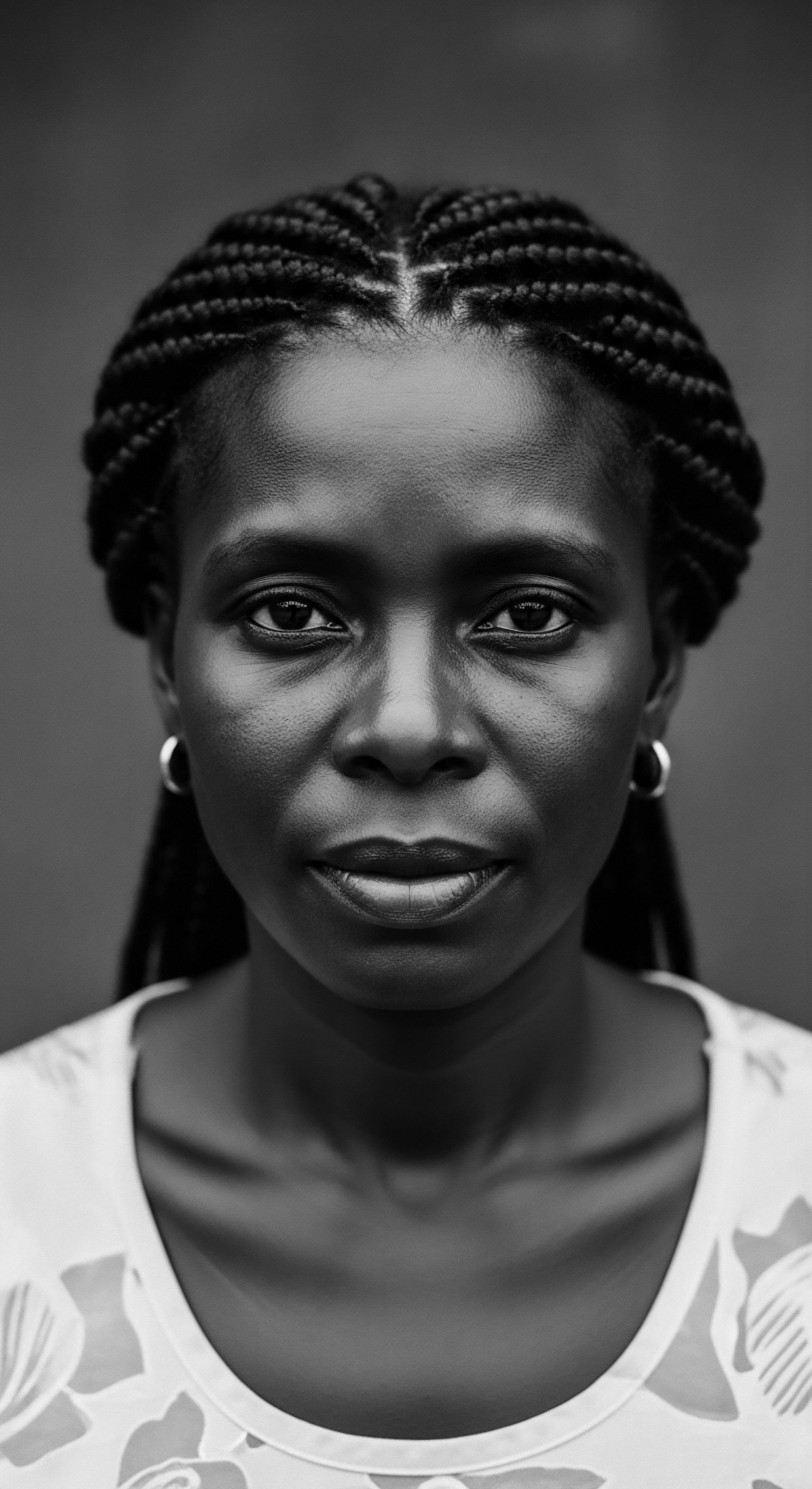
The Living Traditions of Care and Community ❉ The Tender Thread
The application of humidity-protective substances was deeply embedded within communal rituals and expressions of identity. Hair care, particularly for textured strands, has historically been a communal act, a time for sharing knowledge, strengthening bonds, and transmitting cultural values. The systematic preparation and application of these ancestral humidity shields, whether the rich karité butter or other plant extracts, became intergenerational teachings. These were not merely cosmetic applications; they were expressions of profound care, resilience, and an honoring of the self and community.
- Shea Butter Rituals ❉ The communal gathering and processing of shea nuts by women, often referred to as “Women’s Gold,” signifies its economic and social importance beyond its practical benefits . This collaborative endeavor created a shared repository of knowledge concerning the most effective ways to extract, refine, and apply the butter for maximal moisture retention and protection from the elements.
- Oiling Practices ❉ Across various West African cultures, hair oiling with specific botanicals (like marula oil, chebe powder infusions, or palm oil) was a common practice. These oils served to seal in moisture and provide a protective barrier, reducing the susceptibility to frizz and maintaining curl patterns in humid climates . The selection of specific oils was often based on empirical observations of their effect on hair elasticity, shine, and resistance to environmental stress.
- Protective Styling ❉ Often paired with the application of moisture-sealing agents, traditional protective styles like braids, twists, and intricate updos served as an additional, physical humidity shield . These styles minimized the hair’s exposure to the elements, reducing the rate of moisture absorption and preserving the hair’s conditioned state for longer periods, exemplifying a holistic, multi-layered approach to hair preservation.
The very act of preparing and applying these protective treatments was a form of cultural transmission, linking present practices to ancestral wisdom. It affirmed a connection to the land, its bounties, and the collective heritage of managing and celebrating textured hair in its full glory, regardless of climatic challenges.
| Aspect of Hair Care Moisture Sealing Agents |
| Ancestral Practice & Significance (Pre-19th Century) Use of natural butters like shea butter and oils (palm, coconut, marula) applied to hair to create a hydrophobic barrier against environmental moisture. These were understood empirically to prevent dryness and maintain hair’s integrity in humid or dry climates . |
| Modern Scientific Insight & Application (20th-21st Century) Identification of fatty acids (oleic, stearic, linoleic acids) and unsaponifiable lipids in these natural butters as film-forming agents that coat the hair cuticle, reducing its porosity and preventing water penetration. This forms the basis for modern "humidity shield" products . |
| Aspect of Hair Care Styling for Protection |
| Ancestral Practice & Significance (Pre-19th Century) Development of intricate protective styles such as braids, twists, and wraps (e.g. Fulani Silk Method) that physically minimized hair’s exposure to ambient humidity, preserving moisture and shape over extended periods . |
| Modern Scientific Insight & Application (20th-21st Century) Scientific validation of protective styling for reducing environmental exposure and mechanical stress. Research now examines the biomechanics of hair fiber within these styles and the microclimates they create, affirming their role in hair health and moisture management. |
| Aspect of Hair Care Understanding Hair Structure |
| Ancestral Practice & Significance (Pre-19th Century) Empirical observation of how hair reacts to different environments and treatments, leading to adaptive practices. Though without formal scientific language, this knowledge was passed through generations as embodied wisdom. |
| Modern Scientific Insight & Application (20th-21st Century) Microscopic and biochemical analyses revealing the unique elliptical cross-section, lifted cuticle, and lipid composition of textured hair, explaining its susceptibility to humidity and its inherent protective mechanisms (e.g. lower radial swelling in water due to apolar lipids) . |
| Aspect of Hair Care The continuum of hair knowledge, from ancestral understanding to scientific validation, highlights a timeless dedication to textured hair’s resilience and beauty. |
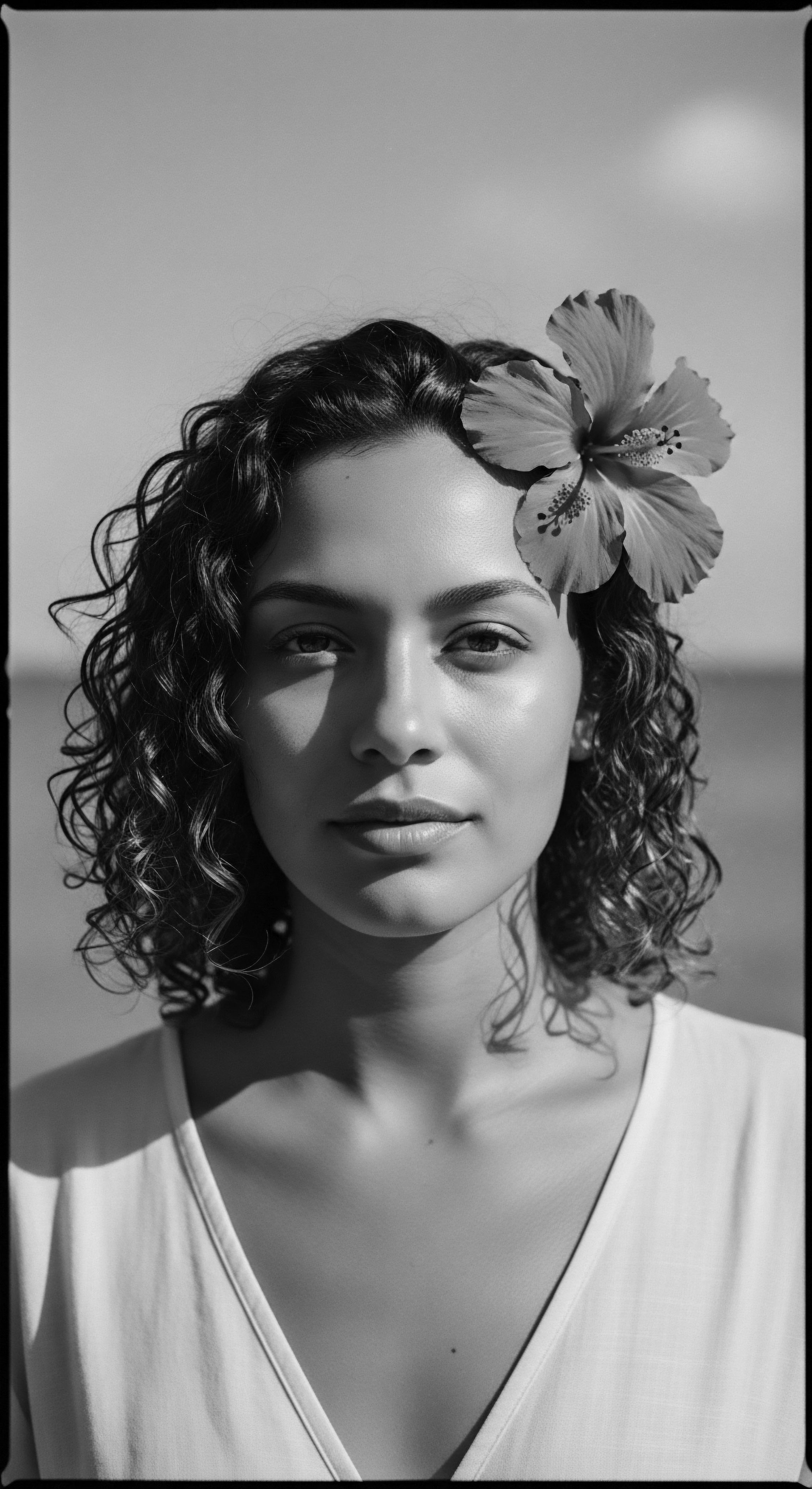
The Unbound Helix ❉ Voicing Identity and Shaping Futures
The contemporary understanding of a Humidity Shield, while rooted in scientific principles, holds significant cultural weight, extending its meaning beyond mere product efficacy to identity and self-determination. For textured hair, managing humidity is not simply about aesthetics; it is about reclaiming autonomy over one’s natural hair state in a world that historically imposed rigid standards of beauty. The ability to wear one’s hair in its natural, coiled, or curly configuration without constant concern for frizz or reversion to an undesired state fosters a deep sense of self-acceptance and pride. This aligns with the “natural hair movement,” a powerful cultural phenomenon that celebrates the diversity and inherent beauty of Black and mixed-race hair.
The continued evolution of Humidity Shield products, especially those that honor and draw inspiration from traditional ingredients and practices, contributes to a more inclusive and respectful beauty industry. It acknowledges the ingenuity of ancestral knowledge and integrates it with contemporary scientific advancements, creating a powerful synergy. This trajectory enables individuals with textured hair to navigate diverse climates with confidence, allowing their hair to serve as a genuine expression of their heritage and personal style. The Humidity Shield, therefore, becomes a tool for empowerment, enabling the hair to remain unbound, truly reflective of its intricate helix and the stories it carries from past, present, and future generations.
The definition of Humidity Shield reaches its deepest comprehension when viewed through the combined lenses of ancestral ingenuity, scientific explanation, and cultural affirmation. It underscores the continuous quest for hair wellness, not as a fleeting trend, but as an enduring commitment to honoring textured hair in all its inherent splendor. This ongoing dialogue between ancient wisdom and modern innovation propels us forward, illuminating pathways for holistic hair care that are both effective and deeply reverent of heritage.

Reflection on the Heritage of Humidity Shield
The journey through the intricate world of the Humidity Shield reveals much more than a technical solution for hair. It unfolds as a meditation on the enduring spirit of textured hair, its deep-seated heritage, and the continuous thread of care that connects us to ancestral wisdom. We observe how the very elemental biology of hair, particularly the unique lipid profile of African hair, hints at an innate resilience against moisture, a gift from our foremothers.
This resilience, however, was never left to chance. Generations cultivated an intimate knowledge of their environments, selecting botanical treasures like shea butter and ingenious styling techniques like the Fulani Silk Method, which served as living, breathing Humidity Shields long before the term was ever coined.
The whispers of those ancient practices resonate through modern science, as contemporary research often affirms the very principles our ancestors understood through observation and profound connection to the natural world. This harmonious blend of empirical wisdom and scientific delineation allows us to appreciate the Humidity Shield not merely as a product, but as a concept woven into the fabric of identity and self-preservation. It speaks to the resourceful creativity that has always defined textured hair care, transforming environmental challenges into opportunities for innovation and adornment.
To honor the Humidity Shield is to honor the hands that once pressed shea nuts into rich butter, the voices that shared secrets of moisture retention across hearths, and the spirits that found beauty and strength in every coil and curl. It is a testament to the fact that hair care for textured strands is a living archive, a narrative of survival, adaptation, and unwavering self-celebration. As we step forward, understanding this heritage deepens our appreciation for every intentional act of care, ensuring the unbound helix continues to tell its powerful story, rooted firmly in the past, yet flourishing vibrantly into the future.

References
- Jackson, D. B. Saeidi, S. F. & Okereke, M. I. (2012). The Science of Black Hair ❉ A Comprehensive Guide to Textured Hair Care. Kansas City, MO ❉ Culture Concepts Inc.
- Sanogo, Y. Sangare, A. & Ouedraogo, A. (2017). Shea (Vitellaria Paradoxa Gaertn. F.) for Livelihoods ❉ A Review of Traditional Uses, Production and Marketing. New York, NY ❉ Springer.
- Robins, R. & Russell, A. (2007). African Ethnobotany ❉ Herbs of Commerce in the Hair and Skincare Industries. Boca Raton, FL ❉ CRC Press.
- Sparrow, S. (2008). A History of African Hair ❉ Beauty, Culture, and Identity. London ❉ Thames & Hudson.
- Gore, M. (2010). Hair Story ❉ Untangling the Roots of Black Hair in America. New York ❉ St. Martin’s Press.
- De la Mettrie, R. (2009). Hair and Hair Care. Paris ❉ Elsevier Masson.
- Powell, S. L. (2014). Naturally Beautiful Hair ❉ Traditional and Modern Hair Care. Atlanta, GA ❉ A&B Publishers Group.
